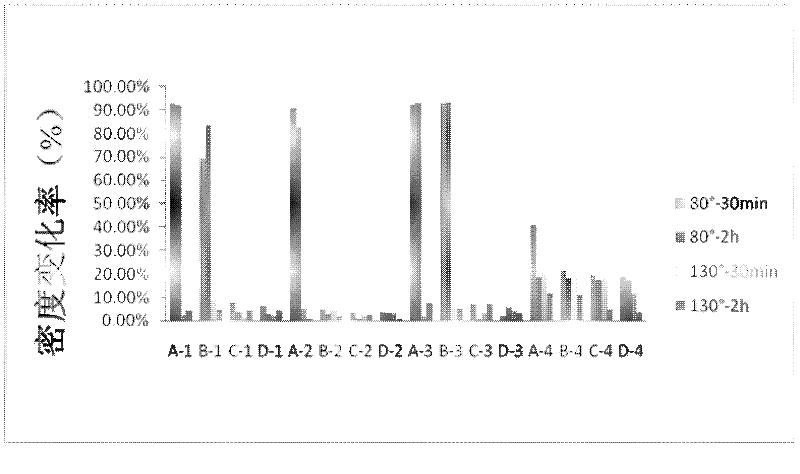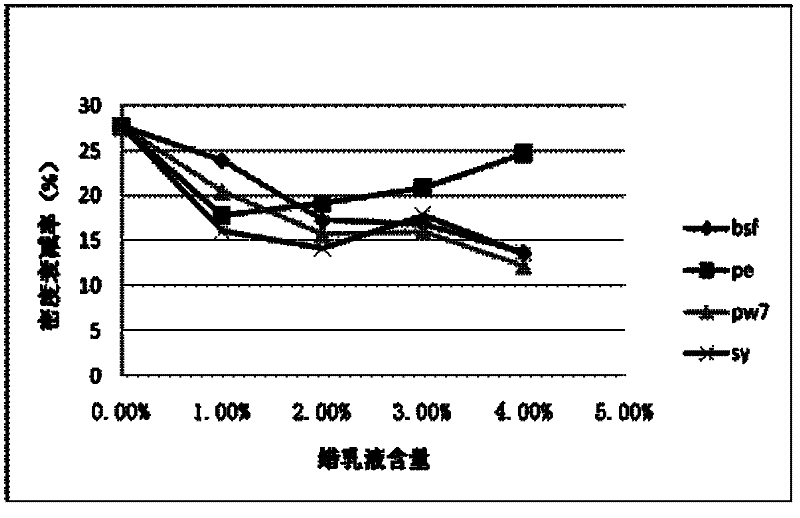Flexographic printing water-based ink for food packaging
A technology of flexographic printing and water-based ink, applied in the direction of ink, household utensils, applications, etc., to achieve the effects of improved safety performance, strong adhesion, and good migration resistance
- Summary
- Abstract
- Description
- Claims
- Application Information
AI Technical Summary
Problems solved by technology
Method used
Image
Examples
Embodiment 1
[0047] 1 Cyan ink formulation for flexographic printing
[0048]
[0049]
[0050] 2 Configuration method, detection content and results
[0051] (1) Weigh each component in proportion, mix and stir for 15 minutes at high speed with a magnetic stirrer or an electric stirrer to obtain a pre-dispersed color paste.
[0052] (2) Pour the color paste into a fast sand mill, add 200 g of medium-sized zirconia beads, and sand at a speed of 2000 r / min for 2.5 to 3.5 hours to obtain evenly dispersed water-based ink.
[0053] (3) Add ethanol (≤8%), isopropanol (≤5%), glycerin (≤6%), etc. to improve the film-forming properties of the ink; use thickener PVP (≤3%) and water (≤10%) ), polyacrylic acid emulsion (≤15%) to adjust the viscosity.
[0054] (4) Use the IGT printability tester (F1 in the Netherlands) to make flexible proofing at 128g / m 2 The coated paper has a density of 1.53 and Lab values of 49.3, -38.4, and -49 when measured with an x·rite500 series densitometer. GB / T...
Embodiment 2
[0061] 1 Ink formulations for flexographic printing
[0062]
[0063] 2 Configuration method, detection content and results
[0064] (1) Use a balance to weigh each component in proportion, and after mixing, stir at a high speed for 15 minutes with a magnetic stirrer or an electric stirrer to obtain a pre-dispersed color paste.
[0065] (2) Pour the color paste into a fast sand mill, add 200g of medium-sized zirconia beads, and sand at a speed of 2000r / min for 2-3 hours to obtain a uniformly dispersed water-based ink.
[0066] (3) Add ethanol (≤8%), isopropanol (≤5%), glycerin (≤5%), etc. to improve the film-forming properties of the ink; use thickener PVP (≤2%) and water (≤10%) ), polyacrylic acid emulsion (≤15%) to adjust the viscosity.
[0067] (4) Use the F1 type printability tester (IGT company in the Netherlands) to do flexible proofing at 128g / m 2 Coated paper, the density measured by x·rite500 series densitometer is 0.9 and the Lab value is 53.6, 46.6, -2.1 respe...
Embodiment 3
[0074] 1 Yellow ink formulation for flexographic printing
[0075]
[0076] 2 Configuration method, detection content and results
[0077] (1) Use a balance to weigh each component in proportion, and after mixing, stir at a high speed for 15 minutes with a magnetic stirrer or an electric stirrer to obtain a pre-dispersed color paste.
[0078] (2) Pour the color paste into a fast sand mill, add 200g of medium-sized zirconia beads, and sand at a speed of 2000r / min for 2-3 hours to obtain a uniformly dispersed water-based ink.
[0079] (3) Add ethanol (≤5%), isopropanol (≤5%), glycerin (≤2%), etc. to improve the film-forming properties of the ink; use thickener PVP (≤2%) and water (≤10%) ), polyacrylic acid emulsion (≤15%) to adjust the viscosity.
[0080] (4) Use the IGT printability tester (F1 in the Netherlands) to make flexible proofing at 128g / m 2 Light ketone paper, measured with an x·rite500 series densitometer, has a density of 0.9 and a Lab value of 88.3, 0.4, an...
PUM
| Property | Measurement | Unit |
|---|---|---|
| particle diameter | aaaaa | aaaaa |
| particle diameter | aaaaa | aaaaa |
Abstract
Description
Claims
Application Information
 Login to View More
Login to View More - R&D
- Intellectual Property
- Life Sciences
- Materials
- Tech Scout
- Unparalleled Data Quality
- Higher Quality Content
- 60% Fewer Hallucinations
Browse by: Latest US Patents, China's latest patents, Technical Efficacy Thesaurus, Application Domain, Technology Topic, Popular Technical Reports.
© 2025 PatSnap. All rights reserved.Legal|Privacy policy|Modern Slavery Act Transparency Statement|Sitemap|About US| Contact US: help@patsnap.com



